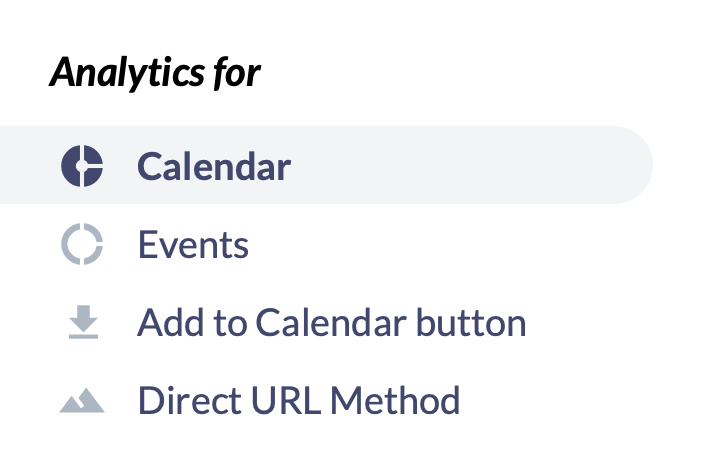Analytics
The Analytics tool provides usage stats and analytics for events and calendars created both within the Dashboard and through our APIs. It is built to help you better understand how your users interact with the different tools you use to share your calendars and events.
You can access Analytics here, or via the link on the Analytics product page or at the bottom of the website.
From the Analytics page, you can choose to view analytics for your Add to Calendar button widgets, the automated events, and your Calendars and Events. The Calendars and Events options will allow you to view analytics for individual calendars and events created via the Dashboard or through the Calendars & Events API.
You can change between these options using the menu on the left side of the analytics page, as shown in the image below.

Please note that analytics are not included on the Hobby or Small Business monthly plans
Analytics for Calendars
To view analytics for a specific calendar, simply select the desired calendar from the drop-down menu. We summarize data by month, and you can easily navigate between different months using the drop-down menu labeled "Period."
The following data is provided for each calendar:
- Summary: total number of events, active subscribers and total subscribers
- Hits: number of times the subscribe page has been visited by users
- Subscribers: number of total & active subscribers each day, and the number of new subscribers per day
- Media: breakdown of calendar vendors used by the users
- Top 10 referring URLs: the top referring URLs to the calendar page
- Live data:
- Recent hits on the subscribe page
- Recent subscribers to the calendar
Analytics for Events
To view analytics for a specific event, simply select the desired event from the drop-down menu. We summarize data by month, and you can easily navigate between different months using the drop-down menu labeled "Period."
The following data is provided for each event:
- Summary: total number of hits and event-adds (both for current month & all time)
- Hits: number of times the event page has been visited by users
- Event-adds: number of times a user has clicked on one of the options in the “Add to Calendar” button on the event page, has downloaded a calendar file, or has been redirected to a calendar service
- Media: breakdown of calendar vendors used by the users
- Top 10 referring URLs: the top referring URLs to the event page
- Live data:
- Recent hits on the event page
- Recent event-adds on the event page
Analytics for Add to Calendar Button Widgets
Add to Calendar Button widget data is summarized by domain. To view analytics for a specific domain, simply select the desired domain from the drop-down menu. Once you select a domain, you’ll be able to easily navigate between different months using the drop-down menu labeled "Period" that will appear.
If you have not yet added a domain, you will need to do so in order to view analytics for any Add to Calendar button widgets on that domain. Simply click the + Add Domain, and you will be shown a page that will guide you through the process of adding your domain.
We only allow for a domain to be registered/verified once.
In case you would like a domain to be transferred to your account, then reach out to [email protected]. Please prepare documentation that you own or have access to the domain.
The following data is provided for each of your domains containing one or more Add to Calendar button widgets:
- Summary: total number of event-adds (both for current month & all time)
- Event-adds: number of times a user has clicked an Add to Calendar button on the domain
- Media: breakdown of calendar vendors used by the users
- Top 10 referring URLs: the top referring URLs from the domain (if you use multiple buttons on your domain, these are the pages containing the buttons that are clicked the most)
- Live data: Recent event-adds on the domain
Analytics for the Automated Events
Analytics for automated events usage is summarized by month. You can easily navigate between different months using the drop-down menu labeled "Period."
The following data is provided for Automated Events usage:
- Hits: number of times users have visited the event page
- Event-adds: number of times a user has clicked on one of the options in the "Add to Calendar" button on the event page, has downloaded a calendar file, or has been redirected to a calendar service.
- Media: breakdown of calendar vendors used by the users
- Top 10 referring URLs: the top referring URLs using the Automated Events
- Live Data:
- Recent hits on the on-the-fly event page
- Recent event-adds / redirects to a calendar service
Watch this tutorial!
Updated 4 months ago
